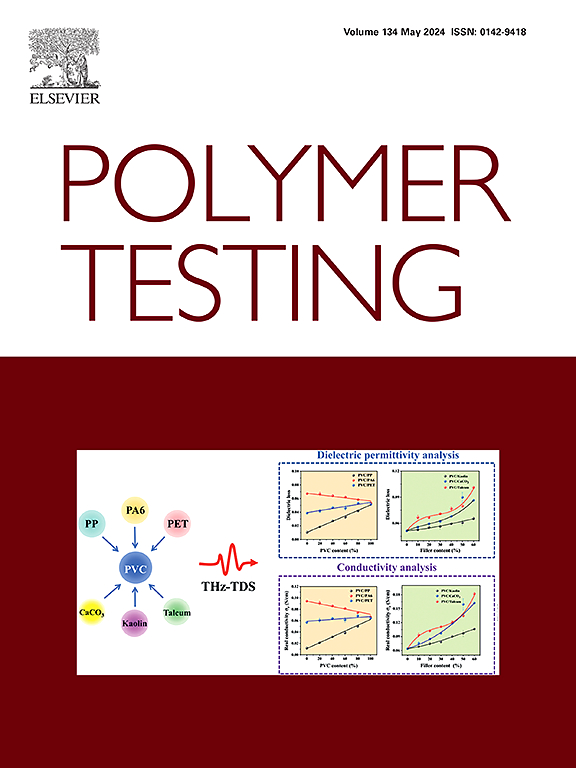夹层结构的表皮/芯断裂韧性:不同实验布置的比较
IF 6
2区 材料科学
Q1 MATERIALS SCIENCE, CHARACTERIZATION & TESTING
引用次数: 0
摘要
热塑性夹层结构由于其固有的强度重量比,可回收性,阻尼能力和易于加工而最突出地使用。尽管如此,蒙皮/岩心脱粘是一种关键的失效模式,限制了蒙皮和岩心之间的应力传递。本研究采用一种经济高效的热成型方法,通过一步非等温过程同时进行复合e-玻璃/聚丙烯(PP)织物固结和闭孔PP泡沫芯粘合。已经开发了几种测试方法来优化和评估界面结合,分析I型断裂能。本研究采用固定和水平滑动约束,对单悬臂梁(SCB)布置的不同变量进行了比较评估,用于测量单聚合物(PP)夹层结构的I型界面断裂韧性。一个刚性的基础与一个灵活的杆负载应用也被使用。此外,研究还分析了蒙皮厚度对试验布置和断裂韧性的影响。带滑动约束的SCB被认为是测量不同蒙皮厚度夹层结构i型主导断裂韧性的最合适配置。然而,对于具有较厚外壳的夹层结构,柔性长载荷杆和滚子底座的配置产生相似的断裂韧性值。裂纹尖端的主要混合模式裂纹扩展限制了具有刚性基础的SCB在评价纯模式i中的适用性,蒙皮厚度显著影响夹层结构的断裂韧性和脱粘路径。在所有I型排列和蒙皮厚度中,裂纹通过致密或未变形的泡沫细胞推进,表明蒙皮/芯融合是通过一步过程进行的。本文章由计算机程序翻译,如有差异,请以英文原文为准。
Skin/core fracture toughness of sandwich structures: a comparison of different experimental arrangements
Thermoplastic sandwich structures are most prominently used due to their intrinsic strength-to-weight ratio, recyclability, damping capabilities, and ease of processing. Nonetheless, skin/core debonding is a critical failure mode, limiting the stress transfer between the skin and core. This research adopts a cost-effective thermoforming approach for simultaneous commingled E-glass/Polypropylene (PP) fabric consolidation and closed-cell PP foam core bonding via a one-stage non-isothermal process. Several test methods have been developed to optimise and evaluate the interfacial bonding, analysing Mode I fracture energy. This study introduces a novel comparative evaluation of different variants of single cantilever beam (SCB) arrangements for measuring the Mode I interfacial fracture toughness of a single polymer (PP) sandwich structure, adopting a fixed and a horizontal sliding constraint for the sandwich panel. A rigid base with a flexible rod for load application was also used. Additionally, the study analyses the effects of skin thickness on testing arrangements and fracture toughness. The SCB with a sliding constraint is considered the most suitable configuration for measuring the Mode I-dominant fracture toughness of sandwich structures with varying skin thicknesses. However, the flexible long-loading rod and roller base configurations yield similar fracture toughness values for sandwich structures with thicker skins. The predominant mix Mode crack propagation at the crack tip limited the applicability of SCB with a rigid base in evaluating the pure Mode I. The skin thickness significantly affects the fracture toughness and debonding paths in sandwich structures. Throughout all Mode I arrangements and skin thicknesses, the crack advanced through densified or undeformed foam cells, indicating skin/core fusion bonding via the one-stage process.
求助全文
通过发布文献求助,成功后即可免费获取论文全文。
去求助
来源期刊

Polymer Testing
工程技术-材料科学:表征与测试
CiteScore
10.70
自引率
5.90%
发文量
328
审稿时长
44 days
期刊介绍:
Polymer Testing focuses on the testing, analysis and characterization of polymer materials, including both synthetic and natural or biobased polymers. Novel testing methods and the testing of novel polymeric materials in bulk, solution and dispersion is covered. In addition, we welcome the submission of the testing of polymeric materials for a wide range of applications and industrial products as well as nanoscale characterization.
The scope includes but is not limited to the following main topics:
Novel testing methods and Chemical analysis
• mechanical, thermal, electrical, chemical, imaging, spectroscopy, scattering and rheology
Physical properties and behaviour of novel polymer systems
• nanoscale properties, morphology, transport properties
Degradation and recycling of polymeric materials when combined with novel testing or characterization methods
• degradation, biodegradation, ageing and fire retardancy
Modelling and Simulation work will be only considered when it is linked to new or previously published experimental results.
 求助内容:
求助内容: 应助结果提醒方式:
应助结果提醒方式:


